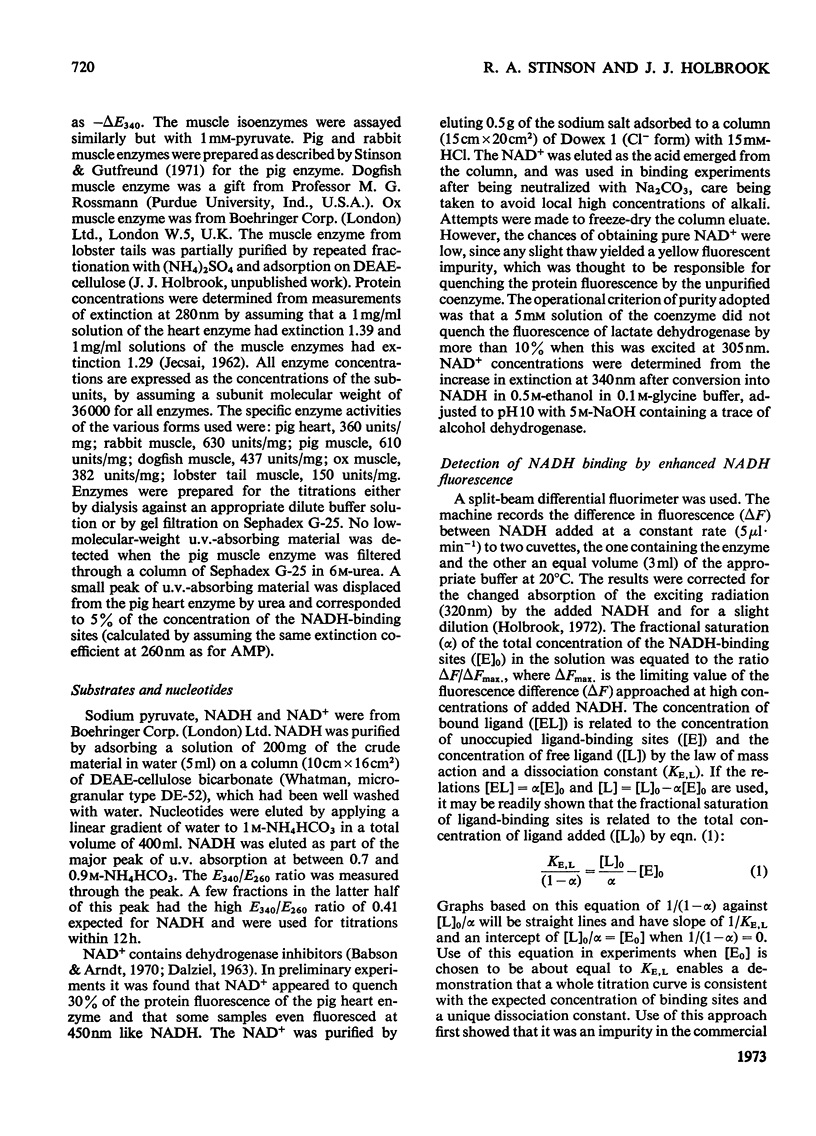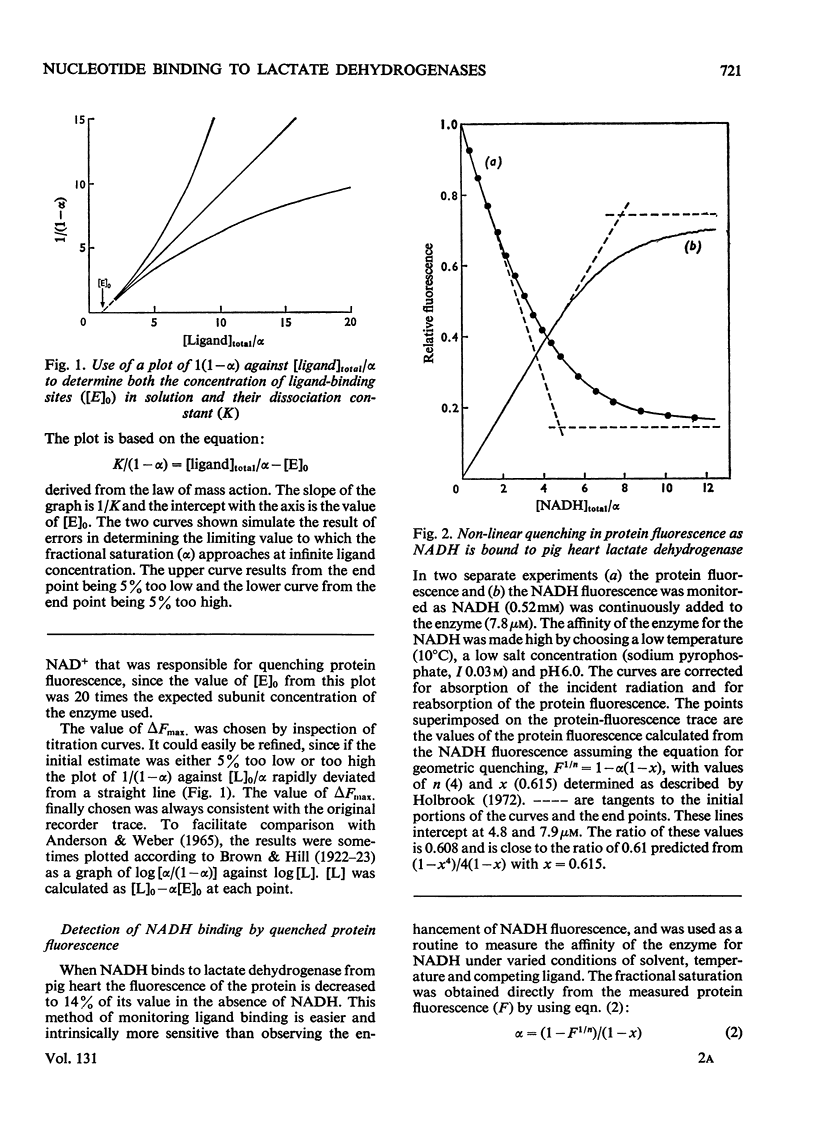Abstract
1. No discontinuities were observed during the continuous titration with NADH of the lactate dehydrogenases of ox muscle, pig heart, pig muscle, rabbit muscle, dogfish muscle or lobster tail muscle. The binding was monitored by either the enhanced fluorescence of bound NADH or the quenched fluorescence of the protein. A single macroscopic dissociation constant, independent of protein concentration, could be used to describe the binding to each enzyme, and there was no need to postulate the involvement of molecular relaxation effects. 2. The affinity for NADH decreases only threefold between pH6 and 8.5. Above pH9 the affinity decreases more rapidly with increasing pH and is consistent with a group of about pK9.5 facilitating binding. Muscle enzymes bind NADH more weakly than does the pig heart enzyme. 3. Increasing temperature and increasing concentrations of ethanol both weaken NADH binding. 4. NADH binding is weakened by increasing ionic strength. NaCl is more effective than similar ionic strengths derived from sodium phosphate or sodium pyrophosphate. 5. Commercial NAD+ quenches the protein fluorescence of the heart and muscle isoenzymes. Highly purified NAD+ does not, and its binding was monitored by competition for the NADH-binding sites. A single macroscopic dissociation constant is sufficient to describe NAD+ binding at the concentrations tested. The dissociation constant is about 0.3mm and is not sensitive to changed ionic strength and to changed pH in the range pH6–8.5.
Full text
PDF









Selected References
These references are in PubMed. This may not be the complete list of references from this article.
- Babson A. L., Arndt E. G. Lactic dehydrogenase inhibitors in NAD. Clin Chem. 1970 Mar;16(3):254–255. [PubMed] [Google Scholar]
- CHILSON O. P., COSTELLO L. A., KAPLAN N. O. HYBRIDIZATION OF LACTIC DEHYDROGENASES IN VITRO BY CONCENTRATED SODIUM CHLORIDE AND BY REVERSIBLE INACTIVATION IN UREA. J Mol Biol. 1964 Nov;10:349–352. doi: 10.1016/s0022-2836(64)80054-1. [DOI] [PubMed] [Google Scholar]
- Cahn R. D., Zwilling E., Kaplan N. O., Levine L. Nature and Development of Lactic Dehydrogenases: The two major types of this enzyme form molecular hybrids which change in makeup during development. Science. 1962 Jun 15;136(3520):962–969. doi: 10.1126/science.136.3520.962. [DOI] [PubMed] [Google Scholar]
- DALZIEL K. The purification of nicotinamide adenine dinucleotide and kinetic effects of nucleotide impurities. J Biol Chem. 1963 Apr;238:1538–1543. [PubMed] [Google Scholar]
- HUMMEL J. P., DREYER W. J. Measurement of protein-binding phenomena by gel filtration. Biochim Biophys Acta. 1962 Oct 8;63:530–532. doi: 10.1016/0006-3002(62)90124-5. [DOI] [PubMed] [Google Scholar]
- Heck H. de A. Porcine heart lactate dehydrogenase. Optical rotatory dispersion, thermodynamics, and kinetics of binding reactions. J Biol Chem. 1969 Aug 25;244(16):4375–4381. [PubMed] [Google Scholar]
- Holbrook J. J., Ingram V. A. Ionic properties of an essential histidine residue in pig heart lactate dehydrogenase. Biochem J. 1973 Apr;131(4):729–738. doi: 10.1042/bj1310729. [DOI] [PMC free article] [PubMed] [Google Scholar]
- Holbrook J. J. Protein fluorescence of lactate dehydrogenase. Biochem J. 1972 Jul;128(4):921–931. doi: 10.1042/bj1280921. [DOI] [PMC free article] [PubMed] [Google Scholar]
- Holbrook J. J., Stinson R. A. Reactivity of the essential thiol group of lactate dehydrogenase and substrate binding. Biochem J. 1970 Nov;120(2):289–297. doi: 10.1042/bj1200289. [DOI] [PMC free article] [PubMed] [Google Scholar]
- Holbrook J. J., Yates D. W., Reynolds S. J., Evans R. W., Greenwood C., Gore M. G. Protein fluorescence of nicotinamide nucleotide-dependent dehydrogenases. Biochem J. 1972 Jul;128(4):933–940. doi: 10.1042/bj1280933. [DOI] [PMC free article] [PubMed] [Google Scholar]
- JECSAI G. Crystalline lactic dehydrogenase from pig skeletal muscle. Acta Physiol Acad Sci Hung. 1961;20:339–346. [PubMed] [Google Scholar]
- Rossmann M. G., Adams M. J., Buehner M., Ford G. C., Hackert M. L., Lentz P. J., Jr, McPherson A., Jr, Schevitz R. W., Smiley I. E. Structural constraints of possible mechanisms of lactate dehydrogenase as shown by high resolution studies of the apoenzyme and a variety of enzyme complexes. Cold Spring Harb Symp Quant Biol. 1972;36:179–191. doi: 10.1101/sqb.1972.036.01.025. [DOI] [PubMed] [Google Scholar]
- SCHWERT G. W., TAKENAKA Y. Lactic dehydrogenase. III. Mechanism of the reaction. J Biol Chem. 1956 Nov;223(1):157–170. [PubMed] [Google Scholar]
- Schwert G. W., Miller B. R., Peanasky R. J. Lactic dehydrogenase. X. A re-evaluation of the effects of pH upon the kinetics of the reaction. J Biol Chem. 1967 Jul 25;242(14):3245–3252. [PubMed] [Google Scholar]
- Stinson R. A., Gutfreund H. Transient-kinetic studies of pig muscle lactate dehydrogenase. Biochem J. 1971 Jan;121(2):235–240. doi: 10.1042/bj1210235. [DOI] [PMC free article] [PubMed] [Google Scholar]
- VERLICK S. F. Fluorescence spectra and polarization of glyceraldehyde-3-phosphate and lactic dehydrogenase coenzyme complexes. J Biol Chem. 1958 Dec;233(6):1455–1467. [PubMed] [Google Scholar]


